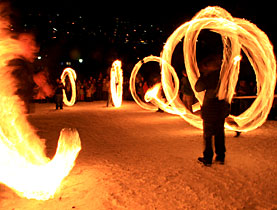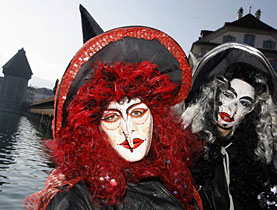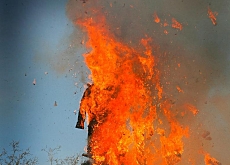Tradition goes up in flames

Fire fascinates, fire brings light. In one way or another it is part of many Swiss spring festivals.
But although people like to think that their fire customs go back to pagan times, most of them are barely more than a century old.
One very widespread custom is the burning of an effigy, often a snowman, at the end of the carnival held in many Swiss towns and villages around the beginning of Lent.
This is frequently interpreted as symbolising the burning of the demon of winter, or alternatively as welcoming the spring with the light of the flames. The best-known example is the Böögg in Zurich, a snowman whose head is packed with fireworks, and who is burnt at the end of April, when the days traditionally had become long enough for workers to put in an extra hour.
Paul Hugger, a retired professor of ethnology at Zurich University and expert on Swiss folk customs, is sceptical about the ancient roots that people like to attribute such events.
The Zurich Böögg took his current form in 1866. “Most similar ceremonies now held elsewhere were copied from it,” he told swissinfo.
In some places the effigy is put on trial before it is burnt. In Fribourg, in western Switzerland, for example, the giant Rababou is accused of everything that has gone wrong over the past year, from the failure to build a local bypass to the shortage of sausage skins: after every accusation the crowd chants “Boo! Boo! Rababou!” until he is set on fire.
“People like passing judgement,” Hugger explained. “And when the guilds who organise carnivals were established in the 19th century, many members were lawyers.”
“Society in villages was much simpler. It’s when people live in towns that they start feeling the need to organise things,” said Hugger.
But such “trials” – a way of poking fun at authority – are also a way of creating a sense of community, which is a vital feature that keeps customs alive. The outsider may well be astonished at the amount of skill, effort and expense that people are prepared to contribute to make something that is going to be burned.
Hom Strom
In the village of Scuol in the southeast of the country they are proud of a custom that is unique in Switzerland. On the first Saturday of February they burn the Hom Strom, or straw man. Straw – “strom” in the local language of Romansh – is right, but the resemblance to a “hom” – man – is minimal.
Straw is twisted and wrapped round a pole, which is then taken to a site above the village and set on fire. The Hom Strom is made by the children and teachers of the local school. The work involves not only making the effigy – which takes two or three hours of prickly work – but also collecting and threshing the straw. It is now grown specially by a local farmer, who is paid by the village. The school goes to the field, where the teachers cut it with scythes, and the children stack it.
It is all part of village life, as retired schoolmaster Balser Biert explained. “Most of the teachers started twisting straw when they were small and when they are teachers themselves they know exactly how it works.”
Nowadays girls take part along with boys in the Hom Strom, but one custom which is still definitely divided along sex lines is “Scheibenschlagen” – the hurling of burning wooden discs, which takes place in the village of Tavanasa and a few villages further down the Rhine valley. The boys make hundreds of wooden discs and take to a hill above the village where they heat them in a fire until they glow.
As they flick them into the village, they call out the name of their girlfriends. “It’s a good evening out with the lads,” one participant told Swiss television.
This is a good example of an event involving courage and risk, and only men could be involved, Hugger pointed out. “The women’s role was to stand by and watch.”
Chienbäse
A unique and spectacular fire custom takes place in Liestal, near Basel. It’s called the “Chienbäse”, or “pine brooms”: participants make torches resembling huge besoms out of pine wood, and carry them through the narrow streets. Also taking part are “fire wagons”, huge piles of wood on wheels, dragged by a whole team of men.
The heat is enormous, and so is the crowd. Those who want to get a good view risk being roasted. The wood on one wagon would be enough to heat a house for the whole winter, but Johannes Iberg, who is in charge of the Chienbäse rejects any idea that this is some kind of waste.
“It’s a tradition, it’s been around for ages. It’s important,” he said, adding that the people who take part do so because they enjoy it. Even if no one came to watch they would carry on.
“Ages” is a relative term: the event as it now exists dates back to the 1920s. The idea seems to have started a little earlier when the local gymnastics organisation used to hold a celebration in the forest, and used flaming torches to light the way home when it was dark.
Hugger points out that in the world today we have no concept of real darkness, and that for our ancestors fire had a role in creating light that modern man is barely aware of. The need for light explains why so many festivals contain an element of fire.
But not everyone attributes fire festivals to pagan ancestors. Some villages have realised recently that fire is a good way to get rid of their Christmas trees – and are already calling their January bonfires a custom.
swissinfo, Julia Slater
The Hom Scuol takes place on the second Saturday in February: it marks the reappearance of the sun between two mountain peaks which dominate the village.
The Böögg is burnt in Zurich on the third Monday in April.
Chienbäse: Sunday after Ash Wednesday.
Scheibenschlagen (Trer Schibettas in Romansh): first Saturday after Ash Wednesday in Danis-Tavanasa and Untervaz.
Many fire customs are linked to carnival (Fasnacht in German), which in turn is linked to the religious calendar. In Roman Catholic areas it is held just before Lent, in Protestant areas usually in the first week of Lent.
Effigies are burned in cities and towns including Baden, La Chaux de Fonds, Fribourg, Herisau, Moudon, Murten, Payerne, Solothurn and Yverdon.

In compliance with the JTI standards
More: SWI swissinfo.ch certified by the Journalism Trust Initiative


You can find an overview of ongoing debates with our journalists here. Please join us!
If you want to start a conversation about a topic raised in this article or want to report factual errors, email us at english@swissinfo.ch.